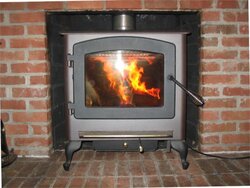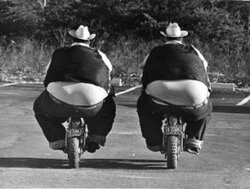Hi, All-
We are thinking about possibly replacing our old stove with something more
efficient. One important concern we have- it must be a rear exit type.
Our present stove feeds through a block off plate at the top of a fireplace on the
main floor of the house using 6 inch pipe at ~20-24 in. height. That pipe angles
up ~1.5 inches over a ~3 foot run, then through a 90 degree elbow and the plate.
The stove sits on an extended flagstone hearth in front of the fireplace. Added
heat baffles protect the wood mantle above and any combustibles directly below
the stove and the flagstone. This setup has served us well, heating an ~1500
square foot rambler very comfortably.
I'm looking at the Buck 261 stove which can be optioned for rear exit. Can anyone
suggest other models to look at with rear exit? I know this greatly limits our choices.
We want a non-catalytic EPA type. Our present stove loads north-south and will
take splits up to 21-22 inches long. The firebox is close to 3 cubic feet. It looks a
bit like the Buck 261 in fact- kind of a 'shop stove' look. We're not trying to get
written up in "Better Homes..." magazine, just to heat our house. Great looks would
be viewed strictly as a bonus, not a necessity.
We have a beautiful fireplace which, alas, never drew well ( it's a 2-sided fireplace).
Designed by a relative who knew nothing about fireplaces, it is pretty but useless.
But with the wood stove, it comes alive and is quite functional. Our 'two-sided
advantage": you can put a 20 inch box fan on the back side and move a *lot*
of air through. This helps to distribute the heat well throughout the main floor.
That fan usually runs on Low and it's quiet.
Suggestions, anyone- in addition to the Buck 261? Thanks!
We are thinking about possibly replacing our old stove with something more
efficient. One important concern we have- it must be a rear exit type.
Our present stove feeds through a block off plate at the top of a fireplace on the
main floor of the house using 6 inch pipe at ~20-24 in. height. That pipe angles
up ~1.5 inches over a ~3 foot run, then through a 90 degree elbow and the plate.
The stove sits on an extended flagstone hearth in front of the fireplace. Added
heat baffles protect the wood mantle above and any combustibles directly below
the stove and the flagstone. This setup has served us well, heating an ~1500
square foot rambler very comfortably.
I'm looking at the Buck 261 stove which can be optioned for rear exit. Can anyone
suggest other models to look at with rear exit? I know this greatly limits our choices.
We want a non-catalytic EPA type. Our present stove loads north-south and will
take splits up to 21-22 inches long. The firebox is close to 3 cubic feet. It looks a
bit like the Buck 261 in fact- kind of a 'shop stove' look. We're not trying to get
written up in "Better Homes..." magazine, just to heat our house. Great looks would
be viewed strictly as a bonus, not a necessity.
We have a beautiful fireplace which, alas, never drew well ( it's a 2-sided fireplace).
Designed by a relative who knew nothing about fireplaces, it is pretty but useless.
But with the wood stove, it comes alive and is quite functional. Our 'two-sided
advantage": you can put a 20 inch box fan on the back side and move a *lot*
of air through. This helps to distribute the heat well throughout the main floor.
That fan usually runs on Low and it's quiet.
Suggestions, anyone- in addition to the Buck 261? Thanks!



 And it will load really long
And it will load really long >
> 